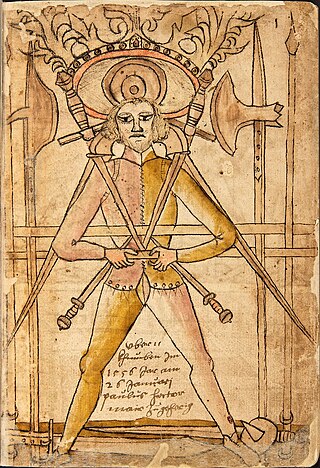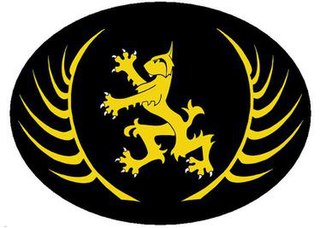
A longsword is a type of European sword characterized as having a cruciform hilt with a grip for primarily two-handed use, a straight double-edged blade of around 80 to 110 cm, and weighing approximately 2 to 3 kg.

Fiore Furlano de Cividale d'Austria, delli Liberi da Premariacco was a late 14th century knight, diplomat, and itinerant fencing master.

Johannes Liechtenauer was a German fencing master who had a great level of influence on the German fencing tradition in the 14th century.

Historical European martial arts (HEMA) are martial arts of European origin, particularly using arts formerly practised, but having since died out or evolved into very different forms.
Martial arts manuals are instructions, with or without illustrations, specifically designed to be learnt from a book. Many books detailing specific techniques of martial arts are often erroneously called manuals but were written as treatises.

The Flos Duellatorum is the name given to one of the manuscript versions of Fiore dei Liberi's illuminated manuscript fight book, written in 1410. There are five other surviving recensions, under the title Fior di Battaglia. Both Flos Duellatorum and Fior di Battaglia translate into English roughly as "The Flower of Battle," from Latin and Italian respectively.

Ringen is the German language term for grappling (wrestling). In the context of the German school of historical European martial arts during the Late Middle Ages and the German Renaissance, Ringen refers to unarmed combat in general, including grappling techniques used as part of swordsmanship.

Half-sword, in 14th- to 16th-century fencing with longswords, refers to the technique of gripping the central part of the sword blade with the left hand in order to execute more forceful thrusts against armoured and unarmoured opponents. The term is a translation of the original German Halbschwert. The technique was also referred to as mit dem kurzen Schwert, "with the shortened sword" in German.

The term Italian school of swordsmanship is used to describe the Italian style of fencing and edged-weapon combat from the time of the first extant Italian swordsmanship treatise (1409) to the days of classical fencing.
Achille Marozzo (1484–1553) was an Italian fencing master, one of the most important teachers in the Dardi or Bolognese tradition.
Bolognese Swordsmanship, also sometimes known as the Dardi school, is a tradition within the Italian school of swordsmanship which is based on the surviving fencing treatises published by several 16th century fencing masters of Bologna, As early as the 14th century several fencing masters were living and teaching in the city: a maestro Rosolino in 1338, a maestro Nerio in 1354, and a maestro Francesco in 1385.
Giuseppe Radaelli was a 19th-century Milanese fencing master and soldier. Often regarded as "the father of modern sabre fencing", his sabre fencing principles were popularised throughout Europe via his students such as Luigi Barbasetti, Ferdinando Masiello, Salvatore Pecoraro, and Carlo Pessina.
The Chicago Swordplay Guild is a modern school of swordsmanship and Western martial arts, and non-profit organization based in Chicago, Illinois, United States. It provides organized instruction in the study and practice of historical European swordplay, with a principal focus on the Italian school of swordsmanship and other martial arts of the 14th–17th centuries. Co-founded in 1999 by Gregory Mele and Mark Rector, the Chicago Swordplay Guild seeks to be consistent with the methodology of the ancient European fencing schools by combining scholarship and research into the teachings of the historical Masters, with the practical knowledge gained through solo and partnered drilling and fencing. Since techniques are taught in reference to how effective they would be in a real encounter, the Guild practices with an absolute emphasis on safety, control, competence, and skill at arms.
Nova Scrimia is an Italian organisation which promotes the teaching of the Italian school of swordsmanship, of stick fencing, of short range fencing (dagger) and of unarmed fencing from the documented period that goes from the 15th century to the 20th century. Nova Scrimia is currently represented in Italy and other European countries, in USA and in Mexico.
Italian martial arts include all those unarmed and armed fighting arts popular in Italy between the Bronze age until the 19th century AD. It involved the usage of weapons. Each weapon is the product of a specific historical era. The swords used in Italian martial arts range from the Bronze daggers of the Nuragic times to the gladius of the Roman legionaries to swords which were developed during the renaissance, the baroque era and later. Short blades range from medieval daggers to the liccasapuni Sicilian duelling knife.
Chivalry Bookshelf was a small press based in the United States founded by Brian R. Price which published booklets and books from 1992 to 2007. It was most notable for its contributions to the Society of Creative Anachronism and the early historical fencing movement and for a dispute about plagiarism and nonpayment of royalties in 2011-12.

Schola Gladiatoria (SG) is a historical European martial arts (HEMA) group based in Ealing, west London, Great Britain, founded in 2001 and led by Matt Easton. It provides organized instruction in the serious study and practice of historical European swordplay. Schola seeks to be consistent with the methodology of the ancient European fencing schools by combining scholarship and research into the teachings of the historical masters, with the practical knowledge gained through solo and partnered drilling, and free play (sparring).

Laurentius Guild (Laurentiusgildet) is a historical European martial arts group headquartered in Aarhus, Denmark with chapters in Nyborg and Vordingborg. Its membership consists of academic researchers specializing in fencing with a focus on the 14th and 15th centuries.
Lanza Longa sometimes also known in Italian as gialda.; modernly known scholarly mostly as lanzalonga, the term was also, normally, translated in Tudor period english as Long Spear, was a medieval polearm typical of Italian municipal infantry, a type of spear between 3 and 4.5 meters long

Filippo Vadi was an Italian fencing master of the 15th century. Together with Fiore dei Liberi, he is one of the earliest Italian masters from whom an extant martial arts manual has survived.










